Are you a cooking enthusiast looking to take your skills to the next level? Look no further! In this Beginner’s Guide to Using an Immersion Blender, we will explore the wonderful world of this versatile kitchen tool. Whether you’re a novice or an experienced chef, this article will provide you with all the essential information you need to know about using an immersion blender. From its various uses in the kitchen to helpful tips and tricks, get ready to revolutionize your culinary creations! So grab your apron and let’s dive right in.
Choosing the Right Immersion Blender
When it comes to choosing the right immersion blender, there are a few factors you should consider. The first thing to think about is the size and weight of the blender. Immersion blenders come in a variety of sizes, so it’s important to choose one that feels comfortable in your hand and is easy to maneuver.
Another important factor to consider is the power options. Immersion blenders can be corded or cordless, and each has its own advantages. Corded blenders tend to have more power and don’t require charging, but they can be less portable. Cordless blenders, on the other hand, offer more flexibility in terms of where you can use them, but they may not be as powerful as their corded counterparts.
Lastly, you’ll want to check for any accessories that come with the immersion blender. Some blenders come with additional attachments such as whisk attachments or chopper attachments, which can be useful for different tasks in the kitchen. Consider your specific needs and choose a blender that comes with the accessories that will be most useful to you.
Preparing Your Ingredients
Before you start using your immersion blender, it’s important to ensure that your ingredients are suitable for blending. While immersion blenders can handle a wide range of ingredients, there are some that may not be suitable. For example, if you’re planning to blend hard ingredients like nuts or ice, you may need a more powerful blender.
In addition to choosing the right ingredients, it’s also important to cut them into small pieces before blending. This helps ensure that the blender can easily process the ingredients and prevents any potential damage to the blades. It’s also important to measure your ingredients accurately, especially when following a recipe. Using the right proportions of ingredients will help ensure that your blended creations turn out just right.

Using the Immersion Blender
Using an immersion blender is quite straightforward, but it’s important to assemble it properly before starting. Make sure to attach the blender shaft securely to the main unit and ensure that it’s locked in place. Once assembled, you can place the blender in the container or bowl that you’ll be using for blending.
When it comes to blending, it’s best to start with a low speed setting. This allows you to control the blending process and prevent any splattering. As you become more comfortable with the blender, you can increase the speed if needed.
Blending Techniques
To achieve the best results with your immersion blender, there are a few techniques you can use. First, try using an up and down motion while blending. This helps ensure that all the ingredients are thoroughly mixed and blended.
Additionally, tilting the blender slightly while blending can help improve mixing. This allows the blades to reach different parts of the ingredients and ensures even blending. However, be careful not to tilt it too much as it may cause splattering.
Lastly, avoid moving the blender too fast while blending. This can cause the ingredients to splatter and create a mess. Instead, move the blender slowly and steadily to ensure a smooth and even blend.

Blending Hot Foods
Blending hot foods with an immersion blender requires some additional precautions. Before blending, it’s important to allow the food to cool slightly. This helps prevent any accidents or burns while using the blender.
When blending hot foods, it’s also best to blend in short intervals. This prevents the blender from overheating and ensures that the ingredients are blended evenly. It’s also important to keep the blender immersed throughout the blending process to avoid splattering.
Cleaning and Storing
After using your immersion blender, it’s important to clean it properly to ensure its longevity. Start by detaching the blender shaft from the main unit and wash it separately. You can clean the blender shaft with warm soapy water, making sure to remove any food residue.
Once the blender shaft is clean, wipe down the main unit with a damp cloth. Avoid submerging the main unit in water as it may cause damage. After cleaning, make sure to store the immersion blender in a dry and safe place where it won’t be damaged.

Recipes to Try with an Immersion Blender
There are countless recipes you can try with an immersion blender, but here are a few ideas to get you started. Immersion blenders are great for making creamy soups and salsas. You can easily blend ingredients like vegetables, herbs, and spices to create delicious and smooth soups and salsas.
Smoothies and milkshakes are another popular option that you can make with an immersion blender. Simply blend together your favorite fruits, yogurt, and milk for a refreshing and nutritious drink. You can also make whipped cream and dressings with an immersion blender, giving your dishes that extra touch.
Troubleshooting Common Issues
Sometimes, you may encounter some common issues while using your immersion blender. If your blender is not turning on, make sure that it’s properly plugged in. If it still doesn’t work, check if the power outlet is functioning or if the blender is in need of repairs.
If your blends are inconsistent, try adjusting the speed settings or the blending time. Experimenting with different speeds and blending times can help you achieve the desired consistency. Additionally, make sure that you’re using an up and down motion while blending to ensure even mixing.
If your immersion blender gets overheated, give it a break and allow it to cool down. Overheating can occur when the blender is used for an extended period of time without breaks. It’s important to follow the manufacturer’s instructions regarding recommended blending times to prevent overheating.

Safety Precautions
When using an immersion blender, it’s important to prioritize safety. Keep the blender away from children and ensure that it’s not accessible to them. The sharp blades can cause serious injuries if mishandled.
Avoid touching the blades when the immersion blender is plugged in, even if it’s not in use. The blades can be extremely sharp and can cause injuries if touched. Always unplug the blender before assembling or disassembling any parts to prevent any accidents.
A Few Tips and Tricks
To get the most out of your immersion blender, here are a few tips and tricks. Experiment with different speeds to find the one that works best for your blending needs. Some ingredients may require a higher speed, while others work better with a lower speed.
Try using different blade attachments that come with your immersion blender. Some blenders come with additional attachments such as whisk attachments or chopper attachments. These attachments can expand the functionality of your immersion blender and allow you to tackle various tasks in the kitchen.
Lastly, don’t limit yourself to just blending tasks. Immersion blenders can be used for tasks beyond blending, such as whisking eggs or making purees. Get creative and find new ways to utilize your immersion blender in the kitchen.
In conclusion, choosing the right immersion blender and understanding how to use it properly can greatly enhance your cooking experience. By considering factors like size, power options, and accessories, you can find a blender that suits your needs. Follow the proper techniques, be mindful of safety precautions, and experiment with different recipes and tips to make the most out of your immersion blender. Happy blending!



